The Brutal Reality of the Iraq War: An Interview with Award-Winning Photographer Michael Kamber on the Hidden War Seen by Photojournalists
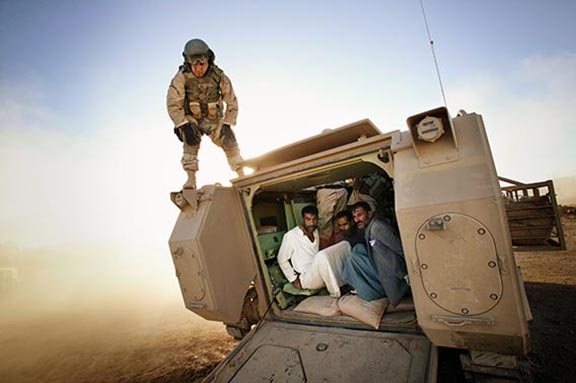
Tal Afar June 2005 Suspected insurgents are detained inside a Bradley Fighting Vehicle to be transported to a detention facility during an early morning raid. Soldiers from the 3rd Armored Cavalry Regiment and Iraqi soldiers moved into Tal Afar with Bradleys, tanks, and Humvees. Helicopters provided air support as the soldiers searched houses and detained suspects. © Christoph Bangert
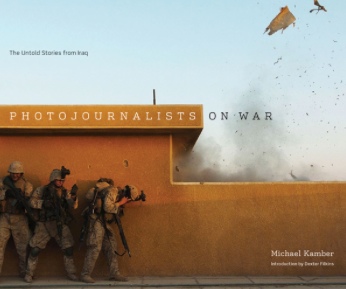 Almost
five thousand American troops were killed in the Iraq War, and it’s
estimated that from 100,000 to more than 600,000 Iraqis, mostly
civilians, died. Many more combatants and noncombatants alike were
physically or emotionally wounded.
Almost
five thousand American troops were killed in the Iraq War, and it’s
estimated that from 100,000 to more than 600,000 Iraqis, mostly
civilians, died. Many more combatants and noncombatants alike were
physically or emotionally wounded.
And, according to a recent study by Harvard public policy professor Linda J. Bilmes, the financial cost of the Iraq war will top a virtually inconceivable four trillion dollars once ongoing treatment for injured veterans and repair of the damaged military force are considered.
After this storm of carnage and wasted resources, Americans left Iraq with a rigidly autocratic government and a bloody civil war that rages more fiercely than ever with Iraq now in free fall and the United States bewildered.
Here, as the fluid, indeterminate Iraq war dragged on year after painful year, public interest waned. News coverage was progressively limited by military censors and editors who sought to shield citizens from the painful realities of America’s nine-year war.
But photojournalists saw the ugly, deformed nature of the war close-up and recorded the human cost of this modern conflict. Now the war as seen by these photographers is available in a groundbreaking book. In Photojournalists on War: The Untold Stories of Iraq (University of Texas Press), award-winning photojournalist Michael Kamber has put together an incomparable photographic and oral history of the Iraq War, the result of a five-year project to preserve history and document photojournalism in the war.
This unflinching account of the war includes revealing interviews with 39 acclaimed photographers and many previously unpublished images of how the war affected soldiers and civilians alike.
Photographers in Iraq were often targets, and many describe harrowing close calls. Mr. Kamber dedicated Photojournalists On War to the 150 Iraqi journalists who gave their lives during the war, and to his friends, prominent photojournalists Tim Hetherington and Chris Hondros, who were both killed while covering stories in Libya in 2011.
Mr. Kamber’s book has been praised widely for the candid accounts from photojournalists and its unsanitized images. In Choice R. L. Abbott wrote: “Much more than a picture book, this is a history and photographic record of a grisly conflict. Time often reduces war to numbers: casualties; the wounded; lives, time, and treasure lost. This carefully designed, thoughtfully delivered book presents--to those fearless enough to look--the agonizing, grim realities of war. . . Highly recommended.” And, from Architects and Artisans: “Anyone who wants to see the real war in Iraq would do well to buy a copy of Michael Kamber's new book, Photojournalists on War. It's a vivid contradiction to many of the images widely broadcast and published during the past decade.”
It’s a book that deserves to be read by every American, beginning with members of Congress and the Joint Chiefs of Staff.
Michael Kamber has worked as a photojournalist for more than 25 years. He covered the war in Iraq as a writer and photographer for The New York Times between 2003 and 2012, and he was the Times’s principal photographer in Baghdad in 2007, the bloodiest year of the war. He is the recipient of a World Press Photo Award, among many honors. Mr. Kamber also helped pioneer the use of multimedia as one of the first journalists to routinely file photography, video and print articles on the Caribbean, the Middle East and West Africa. And he is the founder of the Bronx Documentary Center, a gallery and educational organization dedicated to documentary film and photography.
After the recent ISIS capture of Mosul and other cities in Iraq, Mr. Kamber commented: “All Ican say is that this is the natural outcome of our invasion in 2003. I very much doubt Iraq will continue as a country. It is effectively divided into Kurdish, Sunni and Shia nations. We are witnessing the final destruction of Iraq as a country.”
Mr. Kamber talked about his new book by telephone from New York City a few weeks before the recent ISIS incursion into Iraq.
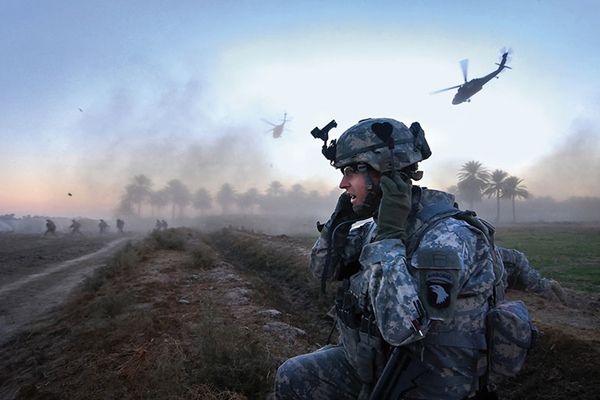
Ubaydi December 29, 2007 Capt. George Morris, commander of B Company, 2-502 Infantry, and his soldiers hit the ground running in the opening salvo of Operation “Patriot Strike.” The soldiers detained ten suspected al-Qaeda conspirators and seized weapons and bomb-making supplies. Photo by Ben Brody
Robin Lindley: How did you come to write this sweeping book on images and oral history of the photojournalists of the Iraq War?
Michael Kamber: I was frustrated when I kept coming home from the war and people here didn’t understand the true story. I would hang out [in Iraq] with my fellow photojournalists and they were always telling these great stories. At a certain point, I felt this was a history that wasn’t being told, so I pulled out a tape recorder and starting recording them. I slowly realized there was something there that should be published.
I was also very frustrated by censorship both by the U.S. military and by the press itself that refused to publish photos that might upset the American public. I had the nagging feeling that the real war was not being shown. If we’re going to go halfway around the world and spend a couple of trillion dollars and lose five thousand Americans and kill thousands of Iraqis, we should know what that looks like. We should have a hard-hitting history for people. They need to know what went on over there.
Robin Lindley: It had to be so frustrating to face censorship at both ends: in Iraq from the military and at home from editors.
Michael Kamber: Exactly. They were pulling punches. Early in the war, there was too much cheerleading and not enough critical thinking about the war. That changed after the Abu Ghraib photos [of abused detainees in U.S. custody], but most of the press was gone by that time.
Robin Lindley: Many of the photojournalists you interviewed stress how important it was for them to record an accurate history of the Iraq War.
Michael Kamber: A lot of us were affected by the Vietnam War. As photojournalists, we’re steeped in history and tradition. We wanted to record the Iraq War and make a real contribution to history. That’s why I went. I had some terrible experiences in ’03 and ’04, and then volunteered to go back. It’s not because I’m a heroic person. I’m not. It was because this was our history and I have a camera and I can set down history. It’s such a privilege to have an opportunity to do that.

Tikrit April 15, 2003 US Marines take a break to shave in front of one of Saddam Hussein’s presidential palaces the day Tikrit fell from Republican Guard rule. As the regime of Saddam Hussein fell across Iraq, soldiers and civilians pillaged his palaces across the country, revealing luxurious accommodations and major weapons caches. Photo by Lynsey Addario
Robin Lindley: How did Iraq compare to other wars you covered?
Michael Kamber: Most of my experience was covering wars in Africa. I covered a couple conflicts in Haiti and the Caribbean, but mostly I covered Somalia, Liberia, and Congo. Every war is different, but I think the Iraq War took us through a crucial period of change in journalism--the war coincided with massive changes in journalism. At the beginning of the war, there were huge budgets and journalists from around the world were sent in. By the end of the war, a lot of newspapers that had come at the beginning were no longer in existence.
Robin Lindley: The complicated embedding agreements evolved during the war. How did that work?
Michael Kamber: There were few restrictions in the beginning, and then it progressively got more and more restrictive as the war went on to the point where it was honestly very hard to work toward the end of the war. And so much of our work depended on personalities, gaining trust, creating relationships with commanders. As Chris Hondros, who was later killed in Libya, told me: “The regulations could be whatever they were but, if you could develop the right relationship with a commander, all that went out the window.”
But embedding definitely got increasingly restrictive. In ’03, I just linked up with a unit and someone said, “Hey, we’re going out on a raid tonight. Why don’t you come along.” And nobody was keeping track. But later, hospitals and prisoners and wounded Americans became off limits. It went on and on.
That said, it wasn’t all the U.S. military’s fault. The war was also part of the historic change in the media and in the media’s relationship to insurgents. Before 9/11, the insurgents really needed the media to get their stories out. If you were covering the Sandinistas [in Nicaragua] or the rebels in Liberia, they had a story to tell and they needed you.
In the beginning of the Iraq War, that was still true but, as the war went on, the insurgents got their own means of production [with] satellite dishes, video cameras and still photographers. They were reaching their intended audience. At that point, the independent journalist just became a liability. Instead of courting us, the Iraqi insurgents were trying to hunt us down and kill us. That pushed us more closely into embeds with the U.S. military. Even if you wanted to explore the lives of the insurgents, it was almost impossible.
Robin Lindley: Several of the photojournalists you talked with were threatened with death. Farah Nosh had dead bodies placed at her door as a warning. And you and your colleagues were all working at great personal risk.
Michael Kamber: There were terrible, terrible days—days when you got up in the morning and had to ask, “Is it worth getting killed today? Is this work worth getting killed for the story, because this could be the day?” And people were killed.
There was a huge press presence in the spring and summer of 2003, but by September 2003, they were already clearing out. You could go places and have a whole city or a whole province to yourself. That was a tremendous responsibility—and it’s what I dreamed of growing up where, as an American, I could go into a war zone and record history and make a difference here. You could go up to Kirkuk or down to Basra and be the only person there getting the story out with a camera.
Robin Lindley: Your book also captures the incompetence and arrogance that characterized the U.S. policy in Iraq—how nobody thought through the consequences of military action.
Michael Kamber: In retrospect I’m a bit ashamed, but I have to be honest. I was a big supporter of the invasion.. I hadn’t worked in the Middle East. I was covering horrible dictatorships in West Africa, and I thought we could get Saddam out and instill democracy.
I was wrong on a number of levels. Mainly, I didn’t realize that, at the top levels of the U.S. military, this was going to be carried out with a degree of incompetence that was absolutely breathtaking. They invaded a country of 30 million people with a skeleton force, without the equipment they needed and without the translators they needed—and made disastrous decisions.
We didn’t have a postwar plan. This is extraordinary. You invade a country of 30 million people and you didn’t sit down to think it out? It’s crazy.
That [lack of thought] has been well documented in many books and it comes through in the interviews in this book too. Soldiers were in the field without enough food, without enough support, with armor that didn’t protect them. This is the richest country in the world, and we couldn’t give our troops what they needed to carry out this military mission? This is the reason that things spun out of control.
Robin Lindley: Your book includes haunting images: a severely burned elderly man who died of his wounds for lack of medical supplies; the aftermath of car bombings; wounded and dead soldiers and women and children. Civilians are in the middle of almost every outburst of violence, often in crowded urban areas.
Michael Kamber: It was a war of car bombs set off in public places. It may be targeting an American Army patrol, but in a crowded marketplace with hundreds of Iraqis, a bomb is set off to kill a handful of Americans, and who’s the collateral damage? And Americans were fighting at long range with drones and helicopters and using infrared cameras from maybe a mile out.
I’m sorry, but civilians were killed in huge numbers. The vast majority of casualties I photographed in the war were civilians. That was the war and that’s what Americans don’t seem to understand. There were no pitched battles, aside from Fallujah where we killed a few hundred men. There were no frontlines. There were no armies facing us. This was a guerilla war from beginning to end and it was fought among civilians. That’s where the insurgents were. They were dug in and hiding amongst civilian populations. That’s where the killing happened, and the civilians were wiped out in huge numbers. There was a terrible cost.
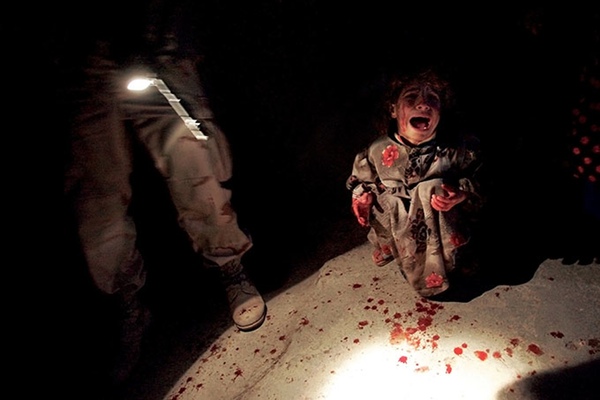
Tal Afar January 18, 2005 Samar Hassan, five, screams moments after her parents were killed by US soldiers from the 25th Infantry Division. The troops fired on the Hassan family car when it unwittingly approached during a dusk patrol in the tense northern town. Her brother, Racan, eleven, was wounded in the shooting. Later, after being treated in the US and returning to Iraq, Racan was killed when insurgents bombed the family home in retaliation for the boy’s trip to the US. Chris Hondros/Getty Images
At times, I covered five or six car bombings in one day. These happened in civilian places, and the next morning the Iraqis have to go to work. They have to eat and go shopping and get their kids to school. They have no choice except to go down the same road where bombs went off the day before.
I probably photographed hundreds of American and Iraqi casualties. You’d come on a car bomb scene where 20 or 30 people were killed. There’s grieving families and body parts and the wounded. It’s not like in the movies where there’s a clean gunshot wound. It’s people blown into small pieces. Sometimes large pieces. And it was every single day.
And I want to remind people that it’s still happening today. Thousands of people are still being killed in Iraq in a civil war didn’t exist until we invaded the country.
Robin Lindley: Have you been in Iraq since we pulled out?
Michael Kamber: I was there when we pulled out and I stayed a couple of weeks after that. It’s a complete dictatorship now and very much has returned to the strong man [leader] status that it had before our invasion. Maliki is a complete dictator. He has jailed the entire opposition. Or they have been killed.
You have no freedom to work there at all. You can’t leave the capital with a camera. Freedom of the press is not enshrined in the Iraqi tradition—certainly not as far as the leaders go. It was hard enough as it was but, once the Americans left, you literally couldn’t take a single picture. I finally said there was no point in me being there.
Probably tens of thousands of people will die in Iraq this year. It’s an ongoing war. As brutal as Saddam was—and he was terrible—we went in there in 2003, and now in 2014, they’re locked in a vicious civil war with car bombs going off on a daily basis.
Robin Lindley: You included Iraqi photojournalists in your book. Have you been in touch with any of them?
Michael Kamber: Yes. I’ve been in touch with Khalid Mohammed, the AP photographer, and a few others. There’s Iraqis on The New York Times crew that’s still there. Their bravery is unbelievable. The Iraqi photographers had it ten times as dangerous as we did. The number of Iraqi journalists killed in the war is over 200 now. When they were found to be working for independent news organizations, they were killed immediately. It was open season on Iraqi journalists.
Robin Lindley: The book also covers returning veterans—whether seriously wounded or in coffins. We get occasional stories about survivors, but your book reflects the magnitude of these losses.
Michael Kamber: That’s it. War is about loss and killing people. When you kill people, their families go through unbelievable anguish and deal with funerals or injuries of soldiers. We need to be honest about that and get away from superheroes of America and how wonderful war is. It’s not wonderful.
Robin Lindley: But your book does not feature political or military leaders such as Bush or Cheney or Rumsfeld or Petraeus.
Michael Kamber: Right, because I was interested in the experience of Iraqi civilians and U.S. soldiers. Let’s get down in the streets to the experience of the Iraqi people and the American soldiers who bore the brunt of the war.
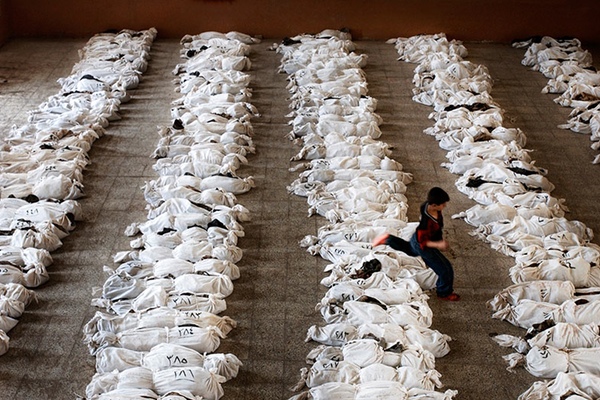
Al Musayyib May 27, 2003 An Iraqi child jumps over the remains of victims found in a mass grave south of Baghdad. The bodies had been brought to this school for identification by family members who searched for identity cards and other clues among the skeletons to identify missing family members. The victims were killed by Saddam Hussein’s government during a Shi’ite uprising here following the 1991 Gulf War. © Marco Di Lauro/Getty Images
Robin Lindley: Is there anything you’d like to add about what you hope readers take from your book on Iraq?
Michael Kamber: I hope that readers take some time to think about how important photojournalism is. Photojournalists are at the forefront of democracy. If we don’t know what’s going on out there, we can’t move forward as a country, and photojournalism is crucial to that. It takes someone who is ethical and never sets anything up and writes accurate captions and has a sense of history.
The power of the still photo holds to this day. You can sit with this history in a book of photographs and others will see it. Sitting with photos of history is a special experience. I believe in that.
My hope is that in 20 or 30 years from now some kid or a student at West Point will pick up the book and say, “Oh, this is what really happened in Iraq.” I don’t see the book as anti-war or pro-war. I just want it to be part of the historical record. I’m not a crusader. They say, “let truth be the prejudice,” and that’s what this is.
Robin Lindley: Are you still involved in conflict photography?
Michael Kamber: I’m not. I’m teaching and working with kids. I’m training young photographers in the Bronx and trying to bring along the next generation.
Robin Lindley: What an outstanding way to share your experience. Thank you for your candor and for your powerful book.